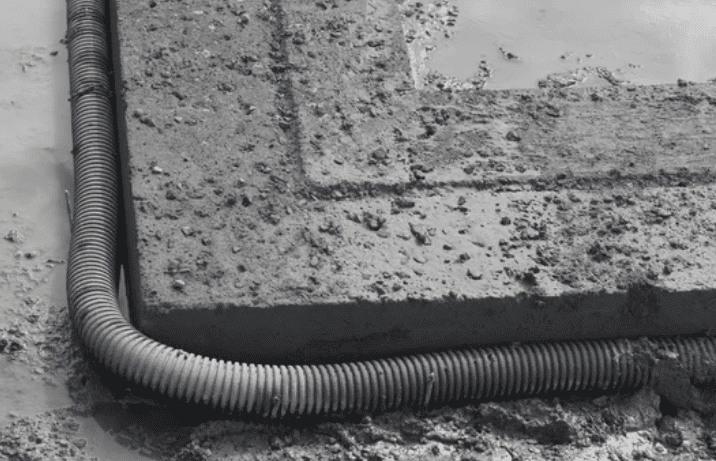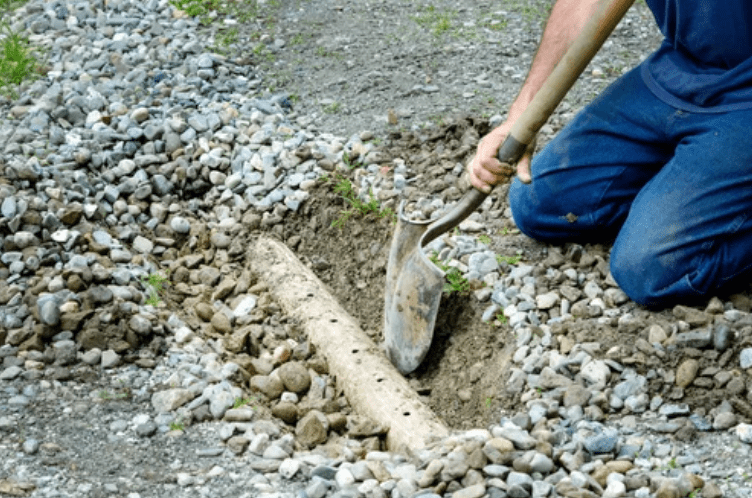What are the French drains?
French drains are an underground drainage system designed to remove surface water from a property. We can use them in various applications, including drywells, swales, trench drains, sump pumps, and cisterns. Professional excavators with experience digging trenches or footings for deep foundation work typically install French drains.
The cost of installing a French drain varies depending on the type of drain (swale v. trench), size (amount of pipe used), depth (shallow trench or deep excavation), and location of the project (urban or rural). The average cost is between $10 – $30 per foot.
How do French Drains Work
A French drain, a weeping tile, is a simple yet effective drainage system that directs excess water away from a building’s foundation or prevents water from pooling in a yard or field.
Here’s a basic overview of how it works:
- Location and Installation: People usually install The French drain in areas of a property with poor drainage or prone to water pooling. The drain is a trench dug into the ground, typically lined with gravel or rock. The installer lays a perforated pipe in the trench, then covers it with more stone or rock.
- Collection of Water: When water collects in the area, it seeps down through the gravel or rock and into the perforated pipe.
- Diverting the Water: The water that enters the pipe is then directed away from the area. This can be to a drainage ditch, a storm drain, a dry well, or even the street. The goal is to move the water to a place where it won’t cause problems, like flooding or water damage to a structure.
- Gradients and Slopes: The French drain system makes use of gravity. The trench is sloped so that water naturally flows down it and away from the area. The trench must be dug to slope away from your home or the area you’re trying to protect.
- Maintenance: Over time, a French drain can become clogged with silt, soil, or roots, reducing its effectiveness. Regular maintenance, including flushing the system with water or using a plumber’s snake, can help to keep it working correctly.
So, in essence, a French drain is a simple system designed to collect water from saturated areas and transport it away to prevent damage or inconvenience.
They often use French drains with other types of systems. Besides serving as a standalone solution, we can integrate them into other drainage methods.
For example:
- Drywells are shallow trenches with a perforated pipe buried at the bottom that drain surface water out of your yard and into an underground cistern or sump pump pit. They’re ideal for areas prone to flooding during heavy rainstorms because they eliminate excess moisture from penetrating deep into your home’s foundation.
- Swales are shallow trenches that direct surface water away from property lines by flowing it through vegetation and soil instead of allowing it to pool up against buildings or roadsides (where it could damage property).
Who installs French drains?
Several types of professionals can install French drains, including:
- Landscapers: Many landscapers can install French drains with their knowledge and experience, mainly if the drainage issue is related to the overall design of your garden or yard.
- General Contractors: If you’re already working with a general contractor on a larger project, they may have the skills to install a French drain.
- Plumbers: Some plumbers may offer this service, which involves installing and maintaining drainage pipes.
- Drainage Contractors: Some contractors specialize in drainage solutions, such as installing French drains, sump pumps, and other drainage systems.
- Basement Waterproofing Companies: A company specializing in basement waterproofing might be a good choice if the French drain is installed to prevent basement flooding.
- DIY: Depending on your skill level and the project’s complexity, you might install a French drain yourself. However, if installed incorrectly, a French drain might not solve your drainage issues and cause more harm than good.
Hiring a professional with proper credentials, positive customer reviews, and experience with this type of work is crucial.
You also want to ensure that the professional understands the specific needs of your property, as French drain installation can vary based on soil type, the slope of your yard, and other factors.
Be sure to ask for an estimate before the work begins and inquire about any guarantees or warranties they offer.
How Much Do French Drains Cost?
The cost to install a French drain can vary significantly based on several factors:
- Size of the Project: A larger area will require more materials and labor, which increases the cost.
- Depth and Length of the Drain: Deeper and longer drains will be more expensive due to the increased labor and materials needed.
- Type of Soil: If the soil is difficult to dig or requires additional preparation, this could increase the cost.
- Materials: The price can vary based on the type of pipe and stone used. Higher-quality materials will generally cost more.
- Location: Costs can vary based on regional pricing differences, the specific location of the property, and the cost of labor in the area.
- Contractor’s Rates: Different contractors will charge different rates for their labor.
The average cost for a French drain installation in the United States ranges from $20 to $30 per linear foot for exterior applications, including materials and labor. Interior French drains, typically more complicated and installed in a basement, were more costly, ranging from $45 to $60 per linear foot.
Remember that these are only averages, and the costs could be lower or higher based on the abovementioned factors. Always ask for a detailed estimate from your chosen professional before moving forward with the project.
French Drains around House
Installing a French drain around the house, often called a perimeter drain, can effectively prevent water from entering your basement or damaging your home’s foundation.
The basic idea is to dig a trench around the perimeter of your house at a depth of the foundation, install a perforated pipe, fill the trench with gravel or similar material, and direct the water away from the home. Here’s a more detailed breakdown of how it works:
- Identify the Problem: The first step is to determine if you have a drainage issue that a French drain can solve. Signs may include water pooling near the foundation, damp or flooded basement, or water stains on the foundation walls.
- Plan the Drain: A French drain needs to slope away from the house, so it’s important to plan where the water will go. This could be a city storm drain, a dry well, or simply a lower point on your property where the water won’t cause issues.
- Dig the Trench: The trench for a perimeter French drain should be dug deep enough to reach the house’s footings. It should also be wide enough to accommodate the pipe and sufficient gravel.
- Lay the Pipe: A perforated pipe is laid in the trench, typically wrapped in a fabric filter, to prevent soil and silt from clogging the pipe.
- Fill the Trench: The trench is filled with gravel or similar material. This allows water to percolate down into the trench and the pipe while the pipe carries the water away from the house.
- Maintain the Drain: A French drain requires effective maintenance like any drainage system. This can include removing debris from the surface of the drain and occasionally flushing the system with water.
Remember, this kind of project is best left to professionals, especially if it involves the foundation of your house. Improper installation might lead to more issues, like a compromised foundation or ineffective drainage.
Always get quotes and opinions from different contractors before proceeding with the work.
French drains are an effective way to control surface water that would otherwise enter your home or business. French drains remove surface water from your property, preventing it from being absorbed into the ground.
This prevents flooding and erosion and protects your foundation from damage caused by muddy soil.

We can use French drains in a wide variety of applications, including:
- Drainage systems for parking lots and driveways
- Stormwater management at construction sites
- Agricultural land use
Conclusion
French drains are an effective way to control surface water that would otherwise enter your home or business. They can be installed in various applications, including drywells, swales, trench drains, sump pumps, and cisterns.
The average cost is between $10 – $30 per foot. Always consult professionals if you have questions about whether a French drain suits your project.


























